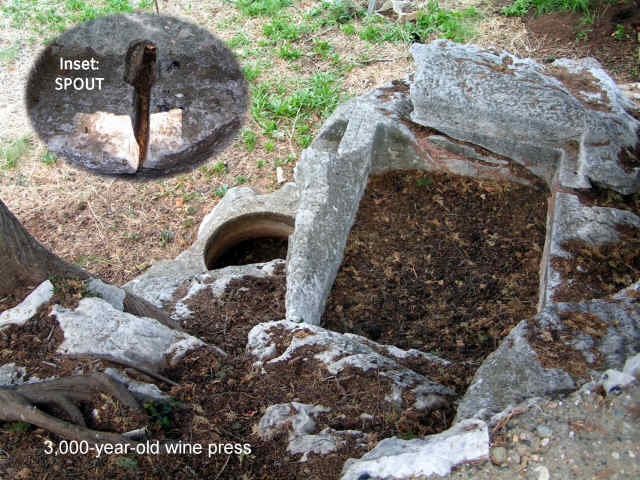This image showes that there is a very long winemaking tradition on Mount Athos.
The fotoalbum of Georg Simms shows more interesting pictures of the place just above Megistis Lavra monastery where probably an ancient community lived.

The round shape we showed you might be a childrens game.

The other round shape we showed you turnes out to be a sundial ! This is what Georg Simms says about it:
A 3,000-year-old sundial. A meter-long iron rod was found alongside to demonstrate the principle (central hole not visible in photo), but the original hour markings, if any, are not legible, except for an apparent at five o’clock, which may have been a later Roman (?) addition.
This is what Georg Simms says in his reaction on our first photos in post 1051.
On my first visit to Great Lavra, I took a walk with a non-Orthodox German man, who had visited Athos more than a dozen times. He went to bring me to the isolated stone cottage, where an old Greek man lived – a friend of his. That’s where these petroglyphs are, near his cottage. You missed the best one. In the back garden of the cottage is a wine-stomping press carved out of the stone. He explained that all these features were created by the primitive agrarian society that lived on that peninsula 3,000 years ago.
Quit interesting stuff. I wonder if Greek archeologists ever investigated or visited this site, and secondly where exactly this isolated stone cattage/kellion lies?
(for more look here, thanks Karl 18/2/14)
hv + wv


According to Herodotos there were several cities on Athos in the antique period. Read the History (chapter 7), written 450 -420 BC). I quote:
`Athos is a great and famous mountain, inhabited by men, and stretching far out into the sea. Where the mountain ends towards the mainland it forms a peninsula; and in this place there is a neck of land about twelve furlongs across, the whole extent whereof, from the sea of the Acanthians to that over against Torone, is a level plain, broken only by a few low hills. Here, upon this isthmus where Athos ends, is Sand, a Greek city. Inside of Sand, and upon Athos itself, are a number of towns, which Xerxes was now employed in disjoining from the continent: these are Dium, Olophyxus, Acrothoum, Thyssus, and Cleonae. Among these cities Athos was divided.`
Wouldn´t it be interesting to find the locations of the ancient towns on Athos?
Pleae have a look at blog nr 573 (http://athos.web-log.nl/athos_agios_oros_/2008/09/573—athos-on.html) to get an idea of where these cities might have been.
Wim
Perhaps I am the German non-orthodox? In my book on Greek sundials you find this one and my ideas about it (www.antike-sonnenuhren.de/).